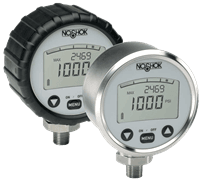Digital Pressure Gauges
Digital pressure gauges provide precise numeric pressure readings, enabling accurate monitoring and control in critical industrial process applications.
/PG7-Digital-Pressure-Gauge/Thumbs/200_main_PG7_Front.png)
/PG5-Digital-Pressure-Gauge/Thumbs/200_main_PG5_Front.png)
/PG2-Digital-Pressure-Gauge/Thumbs/200_main_AP_PG2_Digital_Pressure_Gauge.png)
/PG10-Digital-Pressure-Gauge/Thumbs/200_main_PG10_Front.png)

Digital Pressure Gauges
Digital pressure gauges are advanced electronic instruments designed to measure and display precise pressure readings within industrial process control systems. Utilizing sophisticated pressure sensors, typically piezoresistive or capacitive, they convert applied pressure into accurate digital signals displayed numerically on an integrated LCD or LED screen, often featuring selectable units of measurement and configurable settings.
Their key advantage lies in exceptional accuracy, readability, and flexibility compared to traditional analog gauges. Digital gauges offer immediate, clear numeric displays, reducing operator errors and enhancing process reliability. They often include additional capabilities such as data logging, programmable alarms, peak-hold functions, and digital output signals (such as 4-20 mA, HART, or Modbus), making them highly valuable for integrated control and remote monitoring applications.
Typical industrial applications include critical pressure measurement and monitoring in hydraulic systems, compressed air networks, chemical reactors, gas distribution systems, refrigeration plants, HVAC installations, pump stations, and calibration laboratories. Digital pressure gauges are particularly beneficial in processes requiring high precision, rapid detection of pressure fluctuations, or regulatory compliance through documented pressure data.
Constructed for robust industrial use, digital gauges commonly feature rugged, corrosion-resistant materials such as stainless steel or reinforced polymers and may include ingress protection (IP) ratings suitable for harsh environments. Many models are certified for hazardous areas (ATEX, IECEx, FM, CSA), ensuring safe and reliable operation in explosive or chemically aggressive environments.